 |
| About Alan |
| Tutorials |
| Free files |
| Win9x FAQs |
| E-mail Alan |
| |
| Articles |
| BIV articles |
| Archive |
| Other articles |
| Archive |
| |
 |
|
|
|
Looking
at Futures Past
by Alan Zisman (c) 2005 First published in Performance PC Canada January 2005 It’s tough to be a high-tech prophet. Personally, I try to avoid predicting trends more than a year ahead, and even for that, I look at what happened last year and predict ‘more of the same’. Bill Gates is more courageous than I am. After all, he’s made his billions by betting on future trends, and pushing to refine product development until the market catches up. In November 1994, Gates gave a keynote address at that fall’s Comdex show entitled “Information at Your Fingertips 2005”. Now that it is 2005, I thought it worth a look back to see how he did. It helped that a decade ago, Microsoft’s PR sent me a video tape of the address, featuring a y 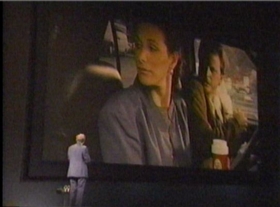 ounger-looking
Gates looking somewhat rumpled in suit and tie. ounger-looking
Gates looking somewhat rumpled in suit and tie.When you’re one of the world’s richest people, you don’t have to just stand up and talk accompanied by a few PowerPoint slides. Instead, his presentation centered on a custom-produced video set in the Seattle of Gates’ vision of the future. Every few minutes, Gates paused the vision to comment on the future technology while a few times the on-screen characters stop to chat with on-stage Bill. Very slick. It wasn’t a glorified Microsoft ad; neither the company nor its products are mentioned in the half-hour production. And Gates noted that it shows a conservative vision: all the technology shown was based on concepts already in development, at least in limited form, in 1994. Our story starts off with the late-night murder of a smuggler on a deserted pier; next morning, we meet a pair of plainclothes cops getting a latte from a street vendor, paying for it by ‘squirting’ funds from a ‘wallet PC’. Next, in a video conversation with their supervisor over the flat panel display in their unmarked squad car, they’re assigned to the murder. Cut to the suburban 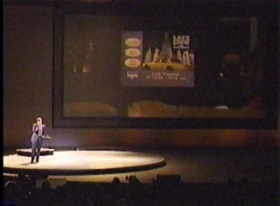 home of
15-year old Jackson Ballard and his mom. Jackson is researching a
school project that he’s put off until the last moment, using
a
combination TV/computer that’s a dead-ringer for this
year’s iMac G5. home of
15-year old Jackson Ballard and his mom. Jackson is researching a
school project that he’s put off until the last moment, using
a
combination TV/computer that’s a dead-ringer for this
year’s iMac G5.Mom takes advantage of a quiet moment before her scheduled 1:00 pm video-conference to catch up on last night’s TV, recorded for her on her own TV/computer. Her personal home page includes links to her favorite shows along with email and other computer tasks. The TV news includes buttons for more information or to record it. Jackson starts looking online for pictures of Pre-Columbian Art; a few clicks take him from a museum in Mexico City to a link to a nearby store that stocks an affordable replica of the very artifact he’d been looking at—perfect for show-and-tell in class. “Mom, can you drive me to Pioneer Square?” 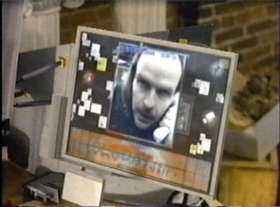 In the
art store, he’s accidentally sold the real (smuggled)
artifact rather
than a replica, which the storeowner is aghast to discover after a
video call from last-night’s murderer. In the
art store, he’s accidentally sold the real (smuggled)
artifact rather
than a replica, which the storeowner is aghast to discover after a
video call from last-night’s murderer.The next day, Jackson showed his class a 30-second animation of dancing Pre-Columbian images. As a teacher, I found it devoid of content, and would have given it a low grade, but the on-screen teacher and students were captivated. Leaving school, he is chased by the storeowner and hired thug and hit by a car while trying to escape. The ambulance attendant, video-conferencing with the emergency-room physician, transmits scans and test results, so diagnosis and treatment plans are in place by the time Jackson arrives at the hospital. 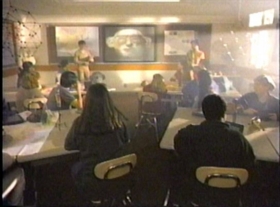 Our cops
make the connection between a car seen at the murder site and at
Jackson’s accident and match the storeowner with
Jackson’s description.
But that night, one of the bad guys breaks into Jackson’s
home,
stealing the artifact and killing his mom. The end. Our cops
make the connection between a car seen at the murder site and at
Jackson’s accident and match the storeowner with
Jackson’s description.
But that night, one of the bad guys breaks into Jackson’s
home,
stealing the artifact and killing his mom. The end.Hold on! In our future 2005, stories ought to have alternate endings. Click. This time, the cops catch the thugs, and discover that like the Maltese Falcon, the artifact is actually solid gold. The (alternative) end. Gates got some things right; compared to a decade ago, digital information, gadgets, and technologies are everywhere. Getting information online is commonplace, and digital hardware is used to create and share photos and music and as a primary way to communicate. 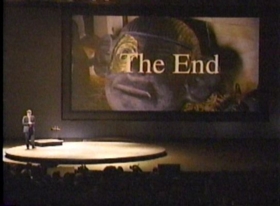 At the
same time, much of Gates’ vision of the future remains in the
future.
Both high tech gear and infrastructure has yet to catch up with this
fantasy 2005. I’d like to have a PDA as capable as the Wallet
PCs
shown, or to pay for purchases by pointing my PDA at a cash register.
While Tablet and Media Center PCs (both using Microsoft Windows XP
versions) have recently become available, neither is widespread nor as
capable as the decade-old fictional versions. At the
same time, much of Gates’ vision of the future remains in the
future.
Both high tech gear and infrastructure has yet to catch up with this
fantasy 2005. I’d like to have a PDA as capable as the Wallet
PCs
shown, or to pay for purchases by pointing my PDA at a cash register.
While Tablet and Media Center PCs (both using Microsoft Windows XP
versions) have recently become available, neither is widespread nor as
capable as the decade-old fictional versions.In the presentation, the characters easily make seamless connections between data; Gates pointed out that this requires an object-oriented databased file system connecting, for example, the art store’s inventory with its suppliers and customers with its outstanding orders. In 1994, Microsoft called this ‘Cairo’, promising to build this capability into Windows NT. Ironically, this past summer, the descendant of that project, now called ‘Windows File System’ was dropped from Longhorn, in order to help this next-generation Windows make a 2006 release target. And that’s the problem with predictions. It’s easy to show us a vision of the future in a video (at least if you have a big enough budget). But it’s harder to make the real world follow along. While today’s real life Jackson may go online on an iMac G5 that looks like the one in this production, finding stuff online and getting it into a slick little animation for school remains much more of a challenge than Gates predicted. Looking back at this 1994 production reminded me of how far we have come in the past decade, but looking at its predictions of seamless ease of use and media convergence has pointed out how far we still have to go. |
|
|
|
|
| Alan Zisman is a Vancouver educator, writer, and computer specialist. He can be reached at E-mail Alan |
